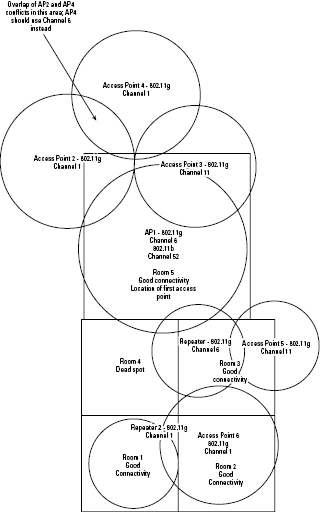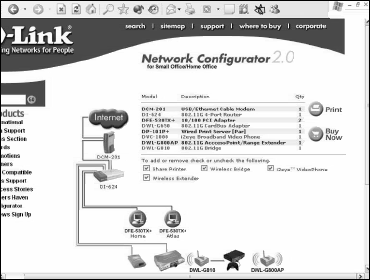The short answer to this question is that you need enough access points to handle both the number of clients that will wirelessly connect to your network as well as provide the range necessary to remove any dead spots in your location.
There is a benefit of having a second (or third) access point in your network, as it provides fault tolerance. Should one of your access points fail, you still have another one to connect to.
You might think that the more access points you have the better, but that is not the case. Every additional access point interferes to some degree with the other nearby access points.
This requires that you plan to use different channels for each access point that overlaps with another. You’ll often see network designers draw wireless overlap diagrams for their site maps which look similar to Venn diagrams. Figure 1 shows an example of a multi-access point site.
The more important consideration is throughput.
If you have an access point that is based on the 11 Mbps 802.11b standard you have the ability to provide on average about 7 Mbps of throughput.
That translates to connections for about 50 intermittent users, 25 knowledge workers (office suite users), and perhaps 15 power users.
For a 54 Mbps 802.11g standard device, you can probably figure on about 35 Mbps throughput on average, which would translate to about 250 intermittent users, 125 knowledge workers, and up to 75 power users.
It’s not uncommon for 802.11b access points to only provide 4 Mbps and to get 11 to 15 Mbps out of a g device, so it pays to be realistic in your assessments.
Based on these types of calculations you can determine your requirements. However, keep in mind that planning for average use will most certainly get you in trouble at peak times.
It’s more realistic to build a wireless LAN that has anywhere from 50 percent to 65 percent of its bandwidth in reserve.
Many, if not most, of the newest access points, wireless NIC cards, and other devices are dualband (ab, bg, or ag), while the higher performing devices are often tri-band (abg).
In performing your throughput calculations, it is best to use the lowest possible throughput protocol in your calculations. You shouldn’t assume that devices will connect up with the fastest protocol unless you have control over the selection and use of different devices in your network.
An assumption of this type means that you don’t have to figure additional overhead into you calculations to keep bandwidth in reserve. It’s a very conservative approach, but provides the margin necessary to absorb not only peaks in your usage but the inevitable growth of the number of wireless devices you’ll be forced to connect over time.
These throughput figures make it clear why companies with large number of workers are forced to add additional access points to their network. If you are setting up a network for a convention, you would want both redundancy and significant capacity for your network.
If the range of coverage is the issue, then you should consider other means of improving your access point(s) range such as repeaters to keep the complexity of your WLAN to a minimum. If you have a particular vendor’s product line in mind, you may find that its Web site has a network configuration tool for building wireless networks.
D-Links Configurator (see Figure 2) will lead you through an analysis of the number of clients, distance you must connect up to, types of content being transferred, and quality and type of NIC cards, and from that analysis suggest the number and placement of devices necessary to implement that network.
All of these choices are multiple choice questions, and there are two decision trees, one for Home & Small Offices and the other for Small to Medium Businesses.
The resulting suggestions are a good starting point for considering what devices you need. There is one other reason to add additional access points to your network, and it’s an important one.
If you have more than one access point, you can subnet your network and provide access to the Internet or network services while limiting which parts of the network can be accessed. If you’re setting up a hotspot that is managed from your company LAN, this is one option to consider.

